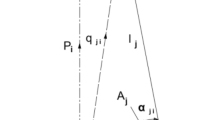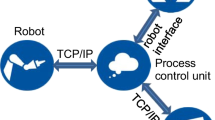Abstract
Automatic polishing is a valuable application of industrial intelligent manufacturing, requiring precise measurement tools and methods to obtain information about the polishing surface. Additionally, effective control strategies are necessary to guarantee optimal polishing results. In order to acquire the details about the polishing surface and the relationship between the object and the manipulator, a measuring device consisting of a two-degree-of-freedom (DOF) parallel platform equipped with a ruby probe is introduced. This device’s properties lead to the implementation of an adaptive trajectory generation algorithm for measurement, and the methods for parameter calibration and accuracy measurement are given. The polished object’s 3D surface is reconstructed through a surface fitting method. The polishing effect is directly determined by the control of position and force. This study developed a force-position decoupling control strategy that ensures constant normal contact force and simultaneous maintenance of tangential feed movement. The experiment’s non-standard column is polished in this paper using a 2DOF parallel measuring device and force-position decoupling control strategy. It compares the experimental effects of polishing using only the data from the measuring device, only the force decoupling control strategy, and both strategies combined. This paper concludes by presenting the surface roughness of the workpiece under the comprehensive polishing strategy. The findings demonstrate that the amalgamation of the measurement and control tactics presented in this manuscript has the potential to significantly contribute to automating the polishing process.




















Similar content being viewed by others
References
J. Li, T. Zhang, X. Liu, Y. Guan and D. Wang (2018) A survey of robotic polishing. in 2018 IEEE International Conference on Robotics and Biomimetics (ROBIO)
Zhu D, Feng X, Xu X, Yang Z, Li W, Yan S, Ding H (2020) Robotic grinding of complex components: a step towards efficient and intelligent machining–challenges, solutions, and applications. Robot Comput Integr Manuf 65:101908
Chen FJ, Yin SH, Huang H, Ohmori H, Wang Y, Fan YF, Zhu YJ (2010) Profile error compensation in ultra-precision grinding of aspheric surfaces with on-machine measurement. Int J Mach Tools Manuf 50(5):480–486
Nagata F, Hase T, Haga Z, Omoto M, Watanabe K (2007) Cad/cam-based position/force controller for a mold polishing robot. Mechatronics 17(4-5):207–216
Amersdorfer M, Kappey J, Meurer T (2020) Real-time freeform surface and path tracking for force controlled robotic tooling applications. Robot Comput Integr Manuf 65:101955
Lin FY, Tian-Sheng L (2005) Development of a robot system for complex surfaces polishing based on CL data. Int J Adv Manuf Technol 26(9):1132–1137
Song HC, Song JB (2013) Precision robotic deburring based on force control for arbitrarily shaped workpiece using CAD model matching. Int J Precis Eng Manuf 14:85–91
Zhao J, Zhao J, Zhang L, Fan C, Han FF (2014) A method for measuring weld bead in grinding and polishing process. Appl Mech Mater 496–500:1489–1493
Wang X, Zhang X, Ren X, Li L, Feng H, He Y, Chen H, Chen X (2020) Point cloud 3D parent surface reconstruction and weld seam feature extraction for robotic grinding path planning. Int J Adv Manuf Technol 107:827–841
Zhang Y, Sun Y, Kazerounian K, Gan Z (2002) Force sensor based calibration of robot grinding. In: International Design Engineering Technical Conferences and Computers and Information in Engineering Conference (Vol. 36533, pp. 1355-1360). American Society of Mechanical Engineers
Xu X, Zhu D, Wang J, Yan S, Ding H (2018) Calibration and accuracy analysis of robotic belt grinding system using the ruby probe and criteria sphere. Robot Comput Integr Manuf 51:189–201
Xie, X.,L. Sun. (2016) Force control based robotic grinding system and application. in 2016 12th World Congress on Intelligent Control and Automation (WCICA)
Tian F, Lv C, Li Z, Liu G (2016) Modeling and control of robotic automatic polishing for curved surfaces. CIRP J Manuf Sci Technol 14:55–64
Tian F, Li Z, Lv C, Liu G (2016) Polishing pressure investigations of robot automatic polishing on curved surfaces. Int J Adv Manuf Technol 87:639–646
Kazerooni H (1988) Automated robotic deburring using impedance control. IEEE Control Syst Mag 8(1):21–25
Seul J, Hsia TC, Bonitz RG (2004) Force tracking impedance control of robot manipulators under unknown environment. IEEE Trans Control Syst Technol 12(3):474–483
Solanes JE, Gracia L, Munoz-Benavent P, Esparza A, Miro JV, Tornero J (2018) Adaptive robust control and admittance control for contact-driven robotic surface conditioning. Robot Comput Integr Manuf 54:115–132
Liao L, Xi FJ, Liu K (2010) Adaptive control of pressure tracking for polishing process. J Manuf Sci Eng 132(1):011015
Hogan N (1985) Impedance control: an approach to manipulation: part i—theory. J Dyn Syst Meas Control 107(1):1–7
Hogan N (1985) Impedance control: an approach to manipulation: part ii—implementation. J Dyn Syst Meas Control 107(1):8–16
Hogan N (1985) Impedance control: an approach to manipulation: part iii—applications. J Dyn Syst Meas Control 107(1):17–24
Funding
This research was funded by the National Natural Science Foundation of China Grant No. 51927809.
Author information
Authors and Affiliations
Contributions
All authors contributed to the study conception and design. H. Z.: methodology, experimental analysis, software, and writing—original draft. C. L.: methodology, investigation, and writing—review and editing. F. G.: conceptualization, funding acquisition, and supervision. C. Q.: data curation, project administration, formal analysis, and validation. All authors read and approved the final manuscript.
Corresponding author
Ethics declarations
Competing interests
The authors declare no competing interests.
Additional information
Publisher’s note
Springer Nature remains neutral with regard to jurisdictional claims in published maps and institutional affiliations.
Rights and permissions
Springer Nature or its licensor (e.g. a society or other partner) holds exclusive rights to this article under a publishing agreement with the author(s) or other rightsholder(s); author self-archiving of the accepted manuscript version of this article is solely governed by the terms of such publishing agreement and applicable law.
About this article
Cite this article
Zheng, H., Liang, C., Gao, F. et al. Automatic surface polishing based on probe measurement and force-position decoupling control. Int J Adv Manuf Technol 129, 2429–2442 (2023). https://doi.org/10.1007/s00170-023-12447-1
Received:
Accepted:
Published:
Issue Date:
DOI: https://doi.org/10.1007/s00170-023-12447-1




